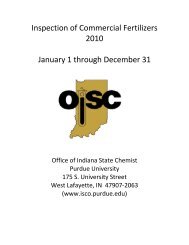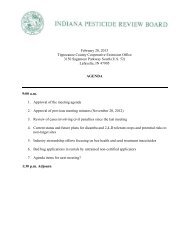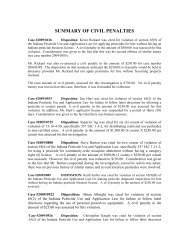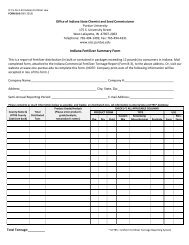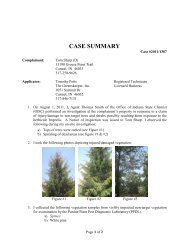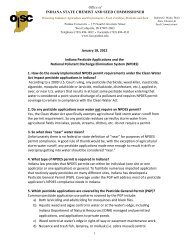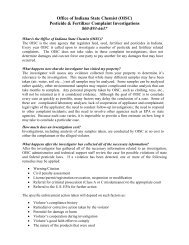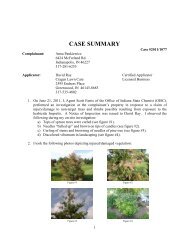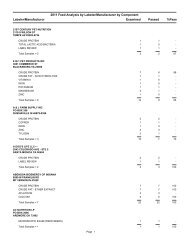Indiana Registry of Soil Scientists Performance Objectives for the ...
Indiana Registry of Soil Scientists Performance Objectives for the ...
Indiana Registry of Soil Scientists Performance Objectives for the ...
Create successful ePaper yourself
Turn your PDF publications into a flip-book with our unique Google optimized e-Paper software.
PLANT AND SOIL ANALYSIS<br />
1. List (correctly spelled) from memory all <strong>of</strong> <strong>the</strong> 18 elements essential <strong>for</strong> plants and<br />
classify each as a macronutrient (primary or secondary) or micronutrient.<br />
2. Given an essential element, write <strong>the</strong> ionic or molecular <strong>for</strong>ms <strong>of</strong> it which are taken<br />
up by plants.<br />
3. List <strong>the</strong> three steps in plant and soil analysis: sampling, analysis, interpretation.<br />
4. Describe in detail how to sample a field <strong>for</strong> plant analysis including sample taking,<br />
preparation and submission. Discuss good soil sampling procedures including<br />
number <strong>of</strong> sub-samples, size and type <strong>of</strong> area to sample, depth <strong>of</strong> sample, and sources<br />
<strong>of</strong> error in sampling.<br />
5. Identify what plant part and at what growth stage one should sample tomatoes, corn<br />
and oak <strong>for</strong> plant analysis.<br />
6. Explain how actual plant analysis is done in a certified lab including what analyses<br />
are made.<br />
7. Given any one <strong>of</strong> <strong>the</strong> elements commonly reported in plant analysis, recall whe<strong>the</strong>r<br />
<strong>the</strong> sufficiency level is more appropriately reported in percent or in ppm.<br />
8. Given values from plant analysis <strong>for</strong> N, P, or K, be able to select <strong>the</strong> values falling<br />
within <strong>the</strong> "sufficiency" range.<br />
9. Explain "Phosphorus Fixation".<br />
10. Explain "Potassium Fixation".<br />
11. Explain why a soil nitrogen test is usually not run and how N needs are determined.<br />
12. List <strong>the</strong> tests run in a "routine" or "basic" soil test.<br />
13. Explain how a soil test lab obtains a soil's cation exchange capacity, and be able to do<br />
<strong>the</strong> calculations when given <strong>the</strong> appropriate data.<br />
FERTILIZERS<br />
1. Discuss animal and municipal wastes: a) as fertilizers; b) from an economic<br />
standpoint; and c) from an environmental standpoint.<br />
2. Describe <strong>the</strong> basic processes <strong>for</strong> manufacturing ammonia, ammonium nitrate, urea,<br />
diammonium phosphates, and nitrogen solutions.<br />
3. Recall <strong>the</strong> chemical composition and percent nitrogen <strong>of</strong> anhydrous ammonia,<br />
ammonium nitrate, urea, 28% N solutions and diammonium phosphate.<br />
4. Discuss <strong>the</strong> advantages and disadvantages <strong>of</strong> <strong>the</strong> gas, liquid, and solid <strong>for</strong>ms <strong>of</strong> N<br />
fertilizer as affected by cost, analysis, and handling ease.<br />
5. Explain how slow release fertilizers are made from urea and <strong>the</strong> special uses <strong>for</strong> <strong>the</strong>m.<br />
8




